Friday 23 April 2010
Audience Feedback
Samantha Milne (Aged 15)
Positive: Ending –When the screen blurs and title come up was praised
Negative: The intitial close up of the couple was too long. I agree with this point and was one of the things I had found wrong with it and wanted too change however Josh at the time had already started to upload it to Youtube so it was too late.
Lauren Farmer (Aged 16)
Positive: Praised the music
Negative: Thought the ending carried suspense- not sure why this was negative?
Henna Mistry (Aged 16)
Positive: Again praised the music, she thought it was very good and set the mood
Louise Pearson (Aged 17)
Positive: She really liked the dark atmosphere created through the mixture of black and white scenes and the music playing. She also liked the contrast between the action shots and the pans across the photos because it added more depth story and opening; she said it looked more like an obsession with the photos being used.
Negative: She said: 'In one of the shots cutting from Sophie and Tom, to Josh through the camera, Sophie changes position from cuddling Tom to looking at the camera, then back in the next shot. This disrupts the flow of the action because it's a little distracting. Also, in the last shot, it isn't totally clear Josh is running towards the 'couple' as the first few times I thought he was running away from them'
Laura Knighton (Aged 17)
Positive: She praised the music saying it 'was awesome', she also said 'the effects were very atmospheric and the end kept me in suspense '
Negative: She found some of the walking around a little repetitive
Monday 19 April 2010
Evaluation- Final Part
Another thing I learnt was to film scenes from multiple angles to make it more interesting than one long take which can get boring and not engage an audience. Although I think my preliminary task video does use various different angles the main task displays a much improved skill of including a wide range of angles and shot types. In addition, I have learnt how to ensure continuity consistently throughout the main task. In the preliminary task there is a moment where a person is going to sit down while addressing some one who is already sat down, that person is talking and there head is in motion. The camera then jumps and they are still taking a few seconds to carry on speaking. This looks unnatural and breaks the flow of action. In the main task however there are moments which the camera cuts successfully between angles and continuity is not broken, for example when the couple are walking and the boy turns his head in one shot and returns in the next. Finally I have learnt much more about the editing software Adobe Premier Pro. In the preliminary task I only cut shots down and placed them next to each other on the timeline but in the main task I learnt to include text, music and various effects to enhance the product. Below is the preliminary task video and above is the final edit for our Thriller, this should demonstrate an improvement in filmmaking, with the Thriller being more complex and focussed.
Evaluation- Part Five
I have learnt a variety of techniques throughout this project. First of all I learnt about aspects of the camera which we would use for filming. I learnt of the 180 degree rule in which once you have placed the camera down you can only film in a certain space whilst in the same scene to avoid the audience having to go through confusion and disorientation. However this was not really a priority to remember whilst filming shots for our opening as there were no typical conversations or shot/reverse shot moments where the 180 degree rule can easily be broken. I learnt how to set the camera to widescreen- the format we were required to film in and the white balance and how to set it, gaining the knowledge that if I didn't then the colour would appear to bright, dark or mismatched. I learnt that whilst filming you must always be careful and not rush, making sure to check everything about the camera is how you want it. The group learnt this lesson due to two of our scenes not being filmed in widescreen due to us forgetting to change the settings, meaning we had to re-film them.
The most important thing that I have learnt and put into practice is the skill of filming scenes using different shot types and angles that can later be edited together to make a particular scene more interesting as you see it from different angles and perspectives. It also breaks up the action more which puts an end to long takes from one angle which can become boring. For example the first scene of a victim walking is broken up between a long shot from a side view, a front view shot and a rear shot as he walks. Below are stills from our opening providing examples of the various shot types and angles we have used:
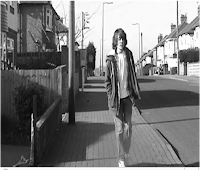
This front view long shot allows you to see the identity of the character, all of their body and the action they are performing and allows you to see the location.

This rear shot allows you to see where the character is headed and the location they see.
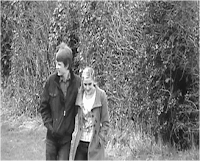
This front view mid- shot allows you to see the character's location and that they are walking but allows more detail of their faces, this is needed to establish their happiness and their innocence and lack of awareness of what is to come.
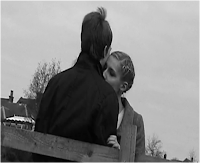
This close up allows us to see more detail of the characters and represent their closeness as a couple. It also allows us to see a change in mood as the girl starts to notice something in the bushes. A close up allows the audience to realise she has seen something, from a long shot they would not be able to tell.
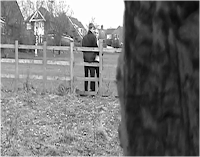
This long shot is from the point of view of the killer. It reveals that someone is watching them and builds up tension, especially when the scene keeps alternating between this shot and the close up shown above.
I also learnt that you can use shots to create meaning or representations. For example we used a high angle shot to make a victim seem vulnerable as they are watched by the killer, unfortunately this scene was cut from our opening. The still below illustrates when we filmed from this angle to create representation.

Another important skill I learnt was how to put the different shot types and angles together in a sequence using the editing software Adobe Premier Pro. I learnt that you had to go through the process of cutting the shot down using the cut tool, and then placing it on the timeline next to the previous shot. I learnt that consistency and continuity are important to maintain throughout the opening. Below are examples from the editing process where I put what I had learnt about cutting, editing shots together and continuity into practice.
- We filmed a scene of a couple walking through a park field from several shots and angles. The first shot of the couple is a front view as they walk towards the camera. We then edited the footage to cut to a long shot from a side angle by placing it next to the previous shot on the timeline. In this shot the boy who I play turns to look to the side, this is where we decided to cut back to the front view. We edited this so the front view shot appears again when I return my head from looking. This creates a flowing scene where the different angles match together, again ensuring continuity.
- For the end of our opening there is a close up of the couple hugging against a fence. We edited this so the camera cuts between both sides of the couple alternating between seeing the boy's face and the back of the girl and vice versa with a long shot from the viewpoint of the killer as the girl starts to notice something. This creates tension which builds up to the climax which is where we placed the shot of where the camera drops and you see the killer run towards the couple.
The camera alternates between these shots.
- We filmed Andrew walking down the street from a side viewpoint from the other side of the road, in front of him as he walked towards the camera and behind him as he walked away. We placed these three clips together on the timeline starting with the side viewpoint before cutting to the front view and then the rear view. We spent a lot of time cutting little sections away so they matched with each other, meaning the continuty was met. For example at the end of sideview shot Andrew walks past the end of a wall and as the camera then cuts to the front view he needs to be in the same position so we cut the clip so it started with Andrew next to the wall meaning it follwed on accurately.
I also learnt how to use various other aspects of Adobe Premier Pro such as inserting titles and music to enhance the opening. I also had a look at the various visual effects you could add such as transition types- we opted for a fade transition as it subtly moved between the scenes. I also learnt how to set up and maintain a blog, something I have never done before. I have enjoyed doing this as it is a different way of presenting your work and allows the insertion of pictures and clips and this makes a change from writing an essay. However I found that doing so can be very fiddly and time consuming. Overall, I have learnt a lot from the project and I am proud of how the group used different shots and angles and edited them together.
Evaluation- Part Four
In addition we have appealed to boys (and presumably some girls) in our teenage target audience by including creating tension and action early on through the use of fast cuts between the point of view of the killer and a close up of the girl looking at something in the trees. This will engage and interest the audience, keeping them on the edge of their seat very early on in the film, this is reinforced by the use of eerie music full of mystery that matches the action well, building up and suggesting something isn't right and something bad is going to happen.
The opening sequence of Quantum of Solace features a car chase, which although is on a much larger scale and is even more action packed (and the action and tension are different kinds to ours) it also uses this strategy to engage the audience early on, create tension and appeal to a young teenage boy audience who like lots of action.
Evaluation- Part Three
If Out of Focus was an actual feature length Thriller it could be distrubted by the Optimum Distribution Company (http://www.optimumreleasing.com/) because it is supported by aid from EM Media- a company specialising in generating business in the East Midlands for filmmakers by providing actors, equipment, props and locations to film with, within the East Midlands. This could be one possibility as we have created this opening in the East Midlands and if it were a real film we could use the support from EM Media (http://www.em-media.org.uk/) to create it, staying within our own location and it would generate business for the area- meeting the requirements of EM Media's agreement for support. However there films do not tend to be large scale action or suspenseful films but more culturally specific films with a niche audience such as 'This is England', illustrated below.


Therefore another distributor that I think would be suitable to distribute our Thriller were it a real film is New Line Cinema. (http://www.newline.com/) Research says: 'New Line Cinema was founded in 1967 and is one of the major American film studios along with 'Warner Brothers' and '20th Century Fox'. Although New Line Cinema was originally an independent film company, it became a subsidiary of Timer Warner 1996 and later merged with larger studio sister 'Warner Brothers' in 2008'
However, if it was distributed by a large company like this it may not be very popular due to no well known actors, locations or a big budget being present in it. Therefore our film would be more suitable to be distributed to local Broadway cinemas across the UK by a company like Optimum (with support from EM Media) rather than multi-plexes which have certain requirements (like the genre and stars) for a film to be accepted to be shown. Although Optimum and EM Media do not make films in the Thriller genre it could be their first attempt at targeting a new audience and market.
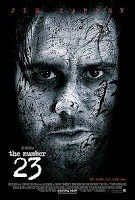
_poster.jpg)

There are several effective ways that our thriller could be marketed. As it is aimed at mature teenagers aged between 16 and 22 and more specifically boys, an effective way of marketing and promoting the film would be to use the internet as this is accessed by most people of these ages and is a large part of their lifestyle. A web- site could be created with trailers, interviews, sneak- peaks and news about the film and a link/ advertisement could be placed on social networking sites as well as film and game sites such as Empire and Gamespot, sites boys of this age are sure to visit. In addition Youtube would be another site to place trailers and clips from the film as this is visited by the majority of people who have access to the internet. This method of advertising the film would be successful as it uses a tool/ technology (the internet) that the target audience is regularly involved with, allowing news of the film to reach out to them. Further marketing methods that advertise through sources the target age are interested in that would be used are posters, television trailers and advertisements in magazines which boys of this age would buy such as game, film and 'lad' magazines. In addition they are 'whats new' services on game consoles like the Playstation 3 that could advertise the film too.




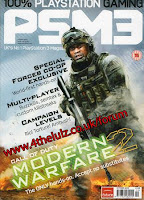
Another advertising method for our Thriller would take inspiration from Univeral's marketing strategy of Bridget Jones' Diary released in 2001. Universal used synergy with various companies to promote the film for their benefit and attract customers to the other company. Synergy benefits both companies and is a tool to gain audience interest and popularity in the film using the services or products of other companies. Universal made deals with the Body Shop, Diet Coke and Virgin Megatores to promote Bridget Jones. The companies selected and promotions used link to the narrative and characters of the film. For example Diet Coke uses 'diet' which links with the aspiration of Bridget to lose weight. Synergy is an effective way of capturing the audience's interest in the film. We could collaborate with companies which our target audience is interested in such as Sony and Apple. However it would be more tricky to promote our film this way as it is not aimed at a mass audience, nor doe sit have a plot that is easy to link products or promotions with. Therefore we could highlight the dangers of abduction of teenagers and promote awareness, this links to the narrative of the film and is a serious current affair.
Evaluation- Part Two



Evaluation- Part One
- Establishing a narrative- the scattered photos (illustrated below) hint to the audience that the people in them are being watched, the scenes of the people in the photos suggest they are targets/ victims being watched and followed. The ending establishes the fact that a killer is targeting teenagers.
- Generates audience interest- by setting up the narrative without giving too much away- only the idea of a killer and victims is known.
- Titles display the makers and stars of the film.
- Suitable music is used to enhance the sequence, establishing mood and atmosphere. In our opening the music is used to create a mysterious and tense atmosphere.
- The Opening sequence acts as a prologue and montage before the film starts properly, this is common in films as existing opening sequences use this style. For example 'Seven', which switches between short shots of different objects and the titles, hinting at the plot and elements in the story. Our opening is similar to this providing clips of past victims of the killer and was inspired by the style of this opening. Below is the opening sequence of Seven.
- No speech is used- a style used in many opening sequences and again another aspect of the opening of the Thriller 'Seven'.
Our opening sequence conforms to the codes and conventions of Thrillers by:
- Fitting into a sub- genre- which is crime/ action
- Establishes a story which would feature detectives trying to stop the killer rather than work out who they are. The identity would only remain hidden during the opening to generate intrigue and interest. This type of plot has the common structure often used in thrillers.
- Establishes a story which could occur on a grand scale (a convention of a Thriller)- mass- murderer, abductions and a grand investigation to stop the killer could all occur later in the film from the narrative that is set up here in our opening..
- Establishes a story which could include large and violent set- pieces- another convention of a thriller.
- Creates Engimas- such as the identity of the killer, the ideology behind the killer's actions and who the victims are and what happens to them
- Tension and suspense is created- through the use of a change in music that is much more tense, slow and signifies danger. The audience is kept on edge as the camera keeps cutting between a close up of the girl- Sophie looking into the trees and a point of view shot of the killer, whilst the music builds up to the climax of the killer dropping the camera and running towards the couple. The combination of the tense music building up slowly and the cuts between the two points of view creates an unnerving finale, where the audience waits for something to happen.
- The title of the film 'Out of Focus' links to part of the film's plot, this is common of thrillers for example The Number 23, the title has significance to the film's story. In our thriller the 'Out of Focus' refers to out of focus pictures that the killer would leave at the scenes of crime as their mark to the police and a link to their methods of murder.
Our Opening Sequence challenges the codes of conventions of actual openings and Thrillers by:
- The use of teenage characters- this would not be the case in actual films as more mature characters would be used as it would be more realisitic and would allow the exploration of a more diverse range of emotions, personalities and themes. However we chose to star in the opening ourselves rather than cast adults due to our acting experience. Although adults make it seem more realisitic, we preferred to not have to waste time being unhappy with the acting. Young characters have a purpose in the story and if the film were real it would go on to feature adult characters.
- By not introducing a protagonist- the characters are victims of the killer, the protagonist would be a detective trying to stop the killer however they are not seen in the opening. This is another trait taken from Seven which is an existing opening that does not introduce a protagonist.
- Not revealing the identity of the villain- Thrillers are about stopping a villain rather than uncovering who they are like in a murder mystery. Although it could be argued we challenge this convention by hiding the killer's identity this was done intentionally in the opening to create suspense and intrigue, if it were a full film we would go on to reveal their identity.
Overall, the opening does conform to the codes and conventions well and the style is an accurate take on the Thriller.
Friday 16 April 2010
Re- Filming of Photo Pan (12th April)
This time we placed a black cloth from the drama department underneath the pin board so we could place other photos around it and was a better effect than carpet. Me and Sophie took it turns to film the pan sequence trying to keep our hands steady and taking several breaks, we filmed for a long time so we could select the best parts later. We also shut the blinds in the room, turned the light off and used a film light to create a dull lighting scehem and dark shadow effect on the images, creating a sinister mood and atmosphere. This was something we wanted to do when filmed the scene originally but did not have the equipment or conditions to do so, so I was glad to be able to do it now. Andrew kept making the light flicker during the pan to create tension and give the effect that a candle in the room was blowing and flickering.




